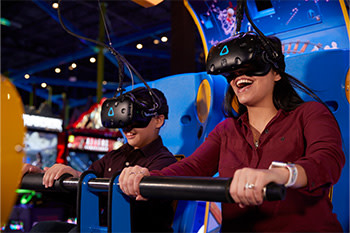When you think of virtual reality in modern days, you likely think of its uses in gaming. Virtual reality has exploded in popularity in the gaming industry, with rapid advancements in the available technology.
PlayStation’s newest virtual reality headset, the PlayStation VR2, is widely anticipated and set to release at the end of 2022. However, virtual reality has many uses beyond gaming and has a long history dating back to the 1920s. Let’s learn more about virtual reality by diving into what it is, what it offers, and how it came to be.
What is Virtual Reality?
Virtual reality, known popularly as VR, involves using computer technology to create a simulation of different environments. Usually, the technology uses a head-mounted display (HMD) to immerse users in 3D worlds. An ideal VR setup simulates all five human senses, but typical VR headsets only simulate sight and sound. There are three types of virtual reality categories:
Non-Immersive: This technology involves a computer-generated virtual environment where the user still experiences their physical environment. This is the most common type of VR, and video games are a typical example.
Semi-Immersive: This type of VR is only partially based in a virtual world. It is often used for educational and training purposes.
Fully Immersive: Currently, there is no fully immersive VR technology, but rapid advances indicate that it may soon be available. Fully-immersive VR would simulate all of the senses. Car racing games are an example of something close to fully immersive VR.
What is the Difference Between Virtual Reality and Augmented Reality?
Augmented reality (AR) is also a popular technology these days. This enhances a user’s view of the real world by adding digital overlays that incorporate artificial objects. With AR, the user views the world directly or through a camera, then a feature is added to that vision. On the other hand, in VR, a whole new scene is created, and a virtual experience is built from scratch.
What are the Uses of Virtual Reality?
Virtual reality isn’t just used in gaming. It’s also used worldwide across various industries to accomplish many different tasks. You may be surprised at some of the uses of virtual reality technology.
Healthcare: VR is often used in healthcare training to help specialists perform precise operations or allow practitioners to become familiar with hospital environments. It’s also being used in cognitive behavioral therapy.
Automotive: Car manufacturers can better analyze road scenarios and car behavior with VR. This technology is being used to develop smart cars that will become popular in future years.
Education: VR can not only be used to train employees in the workforce, but educators can also use it for educational games, field trips, and world experiences that will benefit younger students.
Architecture: VR can help architects envision what they’re building and see how their buildings feel as well.
Digital Marketing: Retailers can show their customers how a product will look in their home, or nonprofits can create more empathetic messaging.
Entertainment: Other than video games, VR is also used in movie theaters and theme parks to enhance storytelling and thrilling experiences.
Social Science and Psychology: Patients can embody other people and experience different worldviews.
Space & Military: Space and warzones can’t easily be accessed, so VR allows trainees to get contextual training before entering dangerous conditions.
Occupational Safety: When workplaces have heavy machinery or natural hazards, VR can help address these issues, so workers know how to handle them without training in actual danger.
Tourism: Potential tourists may be able to explore a vacation destination before booking their tickets.
History of Virtual Reality
The history of virtual reality is long and exciting. The technology has grown significantly over the years, and we will follow its journey from the very beginning.
1929
In 1929, Edward Link created a flight simulator he called the Link Trainer. This flight simulator was entirely electromechanical, and a small motor-driven device mimicked turbulence and disturbances. The US military needed safer ways to train pilots, so they bought six devices for $3,500. In World War II, over 10,000 of these trainers were used for training and improving skills.
1930s
Stanley G. Weinbaum published a science-fiction story called Pygmalion’s Spectacles in the 1930s. The tale actually predicts the creation of virtual reality. In this story, a pair of goggles allows the wearer to see a fictional world and experience it through smell, taste, and touch. It brought the idea of virtual reality to life.
1950s
A cinematographer named Morton Heilig created the Sensorama, an arcade theatre cabinet that stimulated all senses. This cabinet featured stereo speakers, a 3D display, fans, smell generators, and a vibrating chair. Heilig created the Sensorama to fully immerse users in his films, of which he created six.
1960
In 1960, Morton Heilig came out with another invention: the Telesphere Mask. This was the first head-mounted display.
1987
It wasn’t until 1987 that virtual reality as a name was born. Jaron Lanier, who founded a company called VPL Research in 1985 that specialized in VR technology, coined the term virtual reality. He created a range of virtual reality technology, including the Dataglove, Eyephone HMD, and virtual reality goggles.
1991
In 1991, VR entered the gaming industry with Virtuality Group arcade machines. With these machines, players would wear VR goggles and play either multiplayer or single-player games.
1997
In 1997, Georgia Tech and Emory University started using VR to treat PTSD in war veterans. This is still a common treatment for PTSD today, in which veterans are submitted to controlled exposure.
Get the Best VR Experience
For a state-of-the-art VR experience, there’s nothing better than Main Event’s Virtual Reality Arcade. We have 4 virtual reality experience like nothing you’ve seen before. Our Star Wars Lightsaber Dojo lets you face off against Darth Vader himself, along with stormtroopers and droids. Or you can play Hologate, a multiplayer game that takes place in a whole different world. Check out our virtual reality games and visit your local Main Event to dive in!

